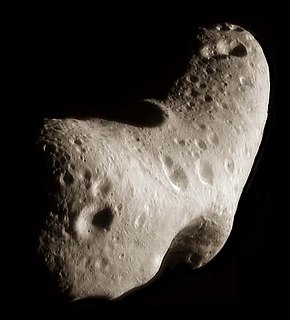
Back 433 Eros Afrikaans 433 إروس Arabic 433 إروس (كويكب) ARZ 433 Eros AST 433 Eros Azerbaijani (433) Эрас Byelorussian 433 Ерос Bulgarian 433 Eros BS (433) Eros Catalan (433) Эрос CE
 Eros – composite image of the north polar region, with the craters Psyche above and Himeros below. The long ridge Hinks Dorsum, believed to be a thrust fault, can be seen snaking diagonally between them. The smaller crater in the foreground is Narcissus. Watters, (2011) | |
| Discovery [1] | |
|---|---|
| Discovered by | C. G. Witt |
| Discovery site | Berlin Urania Obs. |
| Discovery date | 13 August 1898 |
| Designations | |
| (433) Eros | |
| Pronunciation | /ˈɪərɒs/[2] |
Named after | Ἔρως, Érōs[3] |
| |
| Adjectives | Erotian /ɛˈroʊʃ(i)ən/[4] |
| Symbol | |
| Orbital characteristics [1] | |
| Epoch 4 September 2017 (JD 2458000.5) | |
| Uncertainty parameter 0 | |
| Observation arc | 53.89 yr (19,683 days) |
| Earliest precovery date | 29 October 1893 |
| Aphelion | 1.7825 AU |
| Perihelion | 1.1334 AU |
| 1.4579 AU | |
| Eccentricity | 0.2226 |
| 1.76 yr (643 days) | |
| 71.280° | |
| 0° 33m 35.64s / day | |
| Inclination | 10.828° |
| 304.32° | |
| 178.82° | |
| Earth MOID | 0.1505 AU (58.6 LD) |
| Mars MOID | 0.2407 AU |
| Physical characteristics | |
| Dimensions | |
| Mass | (6.687±0.003)×1015 kg[5] |
Mean density | 2.67±0.03 g/cm3[1][5] |
| 5.270 h[1] | |
| 0.25±0.06[1] | |
| 7.0–15[7] | |
| 11.16[1] | |
433 Eros is a stony asteroid of the Amor group, and the first discovered, and second-largest near-Earth object. It has an elongated shape and a volume-equivalent diameter of approximately 16.8 kilometers (10.4 miles). Visited by the NEAR Shoemaker space probe in 1998, it became the first asteroid ever studied from its own orbit.
The asteroid was discovered by German astronomer C. G. Witt at the Berlin Observatory on 13 August 1898 in an eccentric orbit between Mars and Earth. It was later named after Eros, a god from Greek mythology, the son of Aphrodite. He is identified with the planet Venus.[3]
- ^ a b c d e f g h i j k l Cite error: The named reference
JPLdata-2017-06-04was invoked but never defined (see the help page). - ^ "Eros". Oxford English Dictionary (Online ed.). Oxford University Press. (Subscription or participating institution membership required.)
- ^ a b Schmadel, Lutz D. (2007). "(433) Eros". Dictionary of Minor Planet Names. Springer Berlin Heidelberg. p. 50. doi:10.1007/978-3-540-29925-7_434. ISBN 978-3-540-00238-3.
- ^ John Amabile (2016) Changing the Worlds: The For-Profit Plan to Mine Asteroids and Terraform Two Planets in One Human Lifetime
- ^ a b c Cite error: The named reference
Yeomans-Antreas-etal-2000was invoked but never defined (see the help page). - ^ Cite error: The named reference
Baer-2008was invoked but never defined (see the help page). - ^ Cite error: The named reference
NEODys-Eros-2137was invoked but never defined (see the help page).